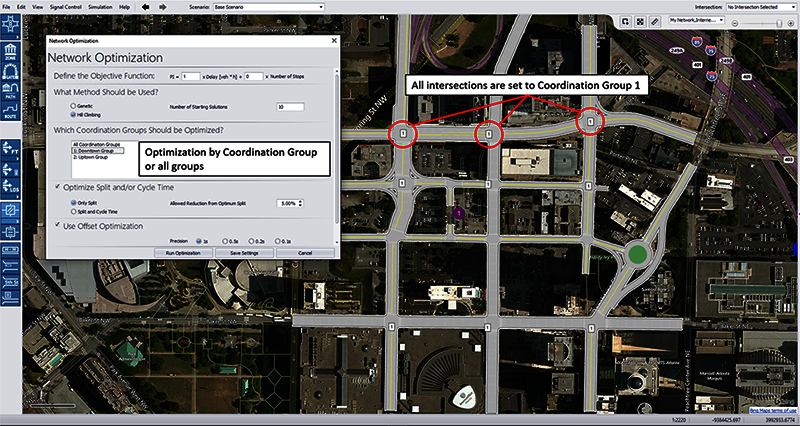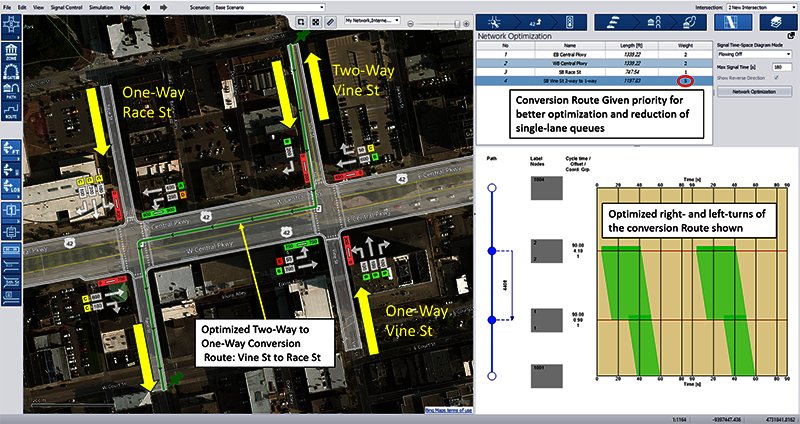Traffic signal optimization with PTV Vistro: Going green
It’s time to get your network coordinated with PTV Vistro. We understand that your traffic signal system needs intelligent traffic signal optimization – and with Vistro, we give you that. PTV Vistro’s powerful coordination tools can optimize entire districts, corridors, and precise routes with our user-friendly graphical-user interface, resulting in accurate, fast, and painless Green Wave optimizations.
Flexible Network Optimization
PTV Vistro provides you with two network optimization methods:
- Traditional zonal coordination using “Coordination Groups”; and
- User-defined and flexible optimization corridors using “Routes”.
Coordination Groups
In PTV Vistro, setting intersections to the same Coordination Group (similar to Zones in Synchro), optimizes the intersections’ offsets, in addition to the cycles and splits, if desired. This zonal optimization calculates the Green Wave between intersections in that Coordination Group. Using multiple Coordination Groups can optimize a combination of districts and corridors as individual groups, or all at the same time using basic equal coordination to a City grid or to straight-line corridors and assigns no priority. But what if your corridor takes a right or a left, or if you have a priority corridor? No worries, PTV Vistro has traffic signal optimization Routes!

Traffic Signal Optimization Routes
PTV Vistro’s Traffic Signal Optimization Routes enhances a Coordination Group’s Green Wave optimization by taking the traditional methodology to the next level. With Routes, you can optimize a corridor that makes a turn or has a higher priority weight over another route.
A typical application of Optimization Routes is identifying several corridors by drawing a Route object, and then optimizing it with or without assigned priority weights within a City grid or district Coordination Groups. This will establish key arterial corridors within the Coordination Group – and increased functionality over traditional zonal coordination, by tying a series of movements together.
Use Cases for Traffic Signal Optimization Routes:
The following situations consist of regularly occurring coordination issues and showcase PTV Vistro’s powerful, easy, and flexible Optimization Routes:The following situations consist of regularly occurring coordination issues and showcase PTV Vistro’s powerful, easy, and flexible Optimization Routes:
Two-way to One-way Conversions
How do you continue coordination for that two-way street terminating into a one-way couple system? Again, a difficult case to solve with Coordination Groups alone, but with Traffic Signal Optimization Routes, defining the main route through multiple turns from the two-way terminus to the corresponding one-way couple is easy (see example in the PTV Vistro installation).
Importantly, PTV Vistro’s time-space diagram shows the complete Green Wave, even if the route goes through a series of turns. This continuous visualization of the Green Wave through turns is a huge benefit of PTV Vistro (not possible in other software platforms), resulting in a better understanding of this complicated Green Wave flow optimization.

Freeway Off-Ramps
What if you have a high-flow dual-left turn on a freeway off-ramp that is contributing to backups at downstream intersections, resulting in gridlock and a ramp overspill?
This case is difficult to solve with just Coordination Groups, but with Vistro’s Traffic Signal Optimization Routes it can be easily solved by drawing a route through the left-turn movement and then through the impacted downstream intersections’ movements, similar to the two-way to one-way conversion example.
To prioritize this left-turning off-ramp Route, a higher weigh greater than the interchange’s through movement Route can be entered. This smart application of PTV Vistro’s Routes increases ramp flushing and improves coordination with the downstream intersections. Here’s a tip: Turn on the Queue Length graphics to visualize the queue improvements.
Event Planning or Detours
Agencies often retime traffic signals for special events, such as festivals, long-term road closures with detours, or frequent alternative route seeking due to freeway closures or breakdowns.
The versatility of PTV Vistro’s Traffic Signal Optimized Routes, fused with a Scenario’s, and Trip Generation and Assignments are extremely effective for quick optimizations of custom events. For example, what if a freeway is closed for bridge repairs and all vehicles need to exit and then ramp surf across the arterial to enter the freeway again? In Vistro, the detoured traffic can be modeled utilizing a trip generation, so there is no need to modify your base count volumes. Then you can simply utilize optimization routes and weighted priorities to get the detoured traffic back on the freeway.